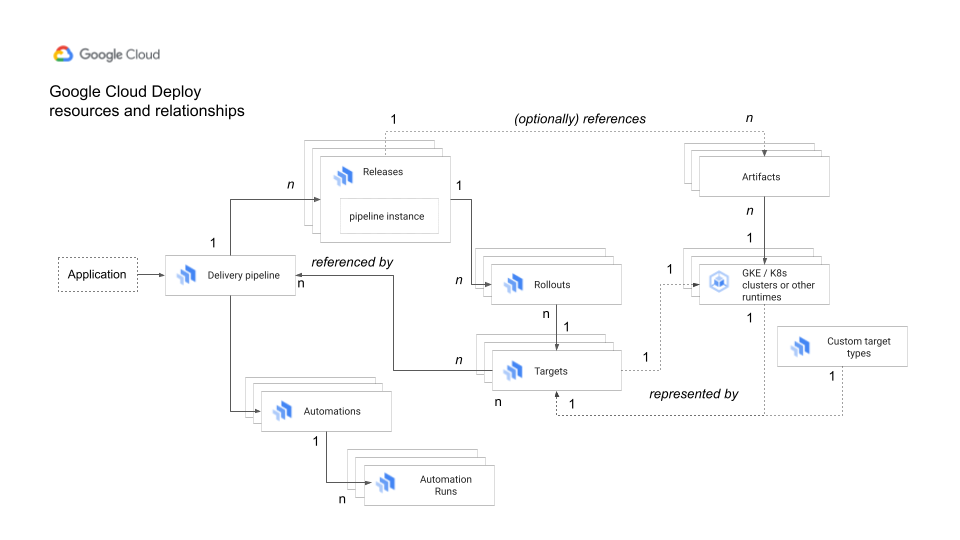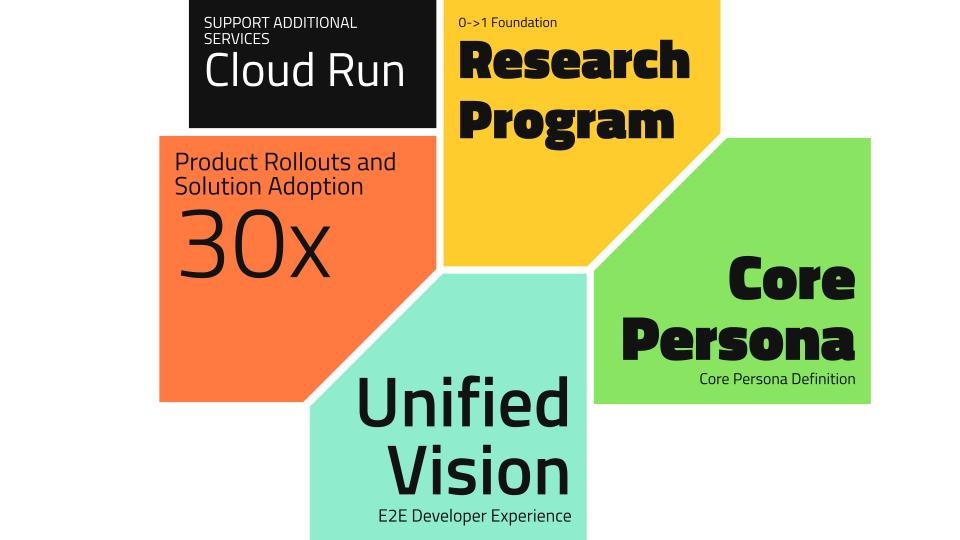Cloud Deploy: Strategic Leadership in 0→1 Product Research & Cross-Functional Scale
Challenge
Led 0→1 research to operationalize the Cloud Deploy vision, translating siloed organizational goals and initial ambiguity into concrete, user-centered feature prioritization and a defined UX strategy.
Context
Google Cloud Deploy is a fully managed continuous delivery service by Google Cloud that automates and streamlines the deployment of applications, particularly to Google Kubernetes Engine (GKE) and Cloud Run environments. Google Cloud Deploy’s growth is part of a broader trend in cloud infrastructure expansion at Google, including enterprise deal size, and new customer segments.
Strategic Importance & Leadership Scope:
Secured cross-functional buy-in from Product, Engineering (50+ engineers), and Operations leadership by establishing shared language and unified vision for GitOps/MLOps. Transitioned from ad-hoc research to a systematic, Director-level research operation with repeatable methodologies that continues to drive Cloud Deploy and broader portfolio decisions. Research findings directly improved suite adoption and enhanced cross-product workflow coherence—positioning Cloud Deploy as a market leader in CI/CD.
Impact
Unblocked critical adoption barriers for enterprise clients, directly influencing product improvements that drove a ~30x increase in usage (100K+ rollouts/month) and sustained Month-over-Month growth.
Championed "visual simplicity" as a core competitive advantage, resulting in the highest CSAT score within the entire CI/CD suite.
Directed the strategy for Cloud Run support, a feature that was pivotal for the Public Preview launch and Top-tier customer acquisitions.
Difficulty
0→1 Challenge: The core challenge was taking a 0→1 product and achieving market-product fit by clarifying complex practices and ensuring cross-product cohesion within the Google Cloud ecosystem.
Complexity of Domain: The core difficulty was operating in highly technical, rapidly evolving domains like GitOps and MLOps, making research questions often intertwined with bigger engineering subject questions. This required not just understanding user needs but defining the problem space itself, especially for customers not using managed services (Non-Vertex AI MLOps users)
Strategic Risk: I had to quickly deliver research that would inform a major de-investment decisions (GCE support), requiring rigor and speed to influence the strategy of the entire DevOps portfolio.
Research Difficulty: The target user base—DevOps engineers—often viewed CI/CD as an afterthought, making recruitment and feedback collection challenging.
Organizational Pain and 3P product usage: While there was a observed market gap, competitive products were positioned to keep up with the product gap in core user journeys.
Methodology
Built a strong foundation for UX needs and a UXR program that can scale with the growth of the product.
Problem Space Definition(with Surveys): Define a core technology of the product GitOps for an engineering organization, providing a shared language and foundational problem space for Cloud Deploy’s initial feature set. This included tapping into internal Google engineering organization and architects in customer organization.
Recorded multi quarter customer insights(with Longitudinal Diary Studies) With the product moving from 0->1, executed a rigorous, multi-week and multi-phase diary study.
Vendor Competitive Evaluations: Secured executive budget and Invested the team to run competitive studies to understand the landscape. Was involved in mentoring multiple vendor UXRs to validate team hypthesis.
Multi-Product Leadership- Championed cross-product UX cohesion by leading a multi-quarter, four-product (Cloud Run, Serverless, Cloud Deploy, Config Controller) effort, co-writing the Product Requirements Document (PRD) based on research findings to launch Cloud Run as a custom target.
Research Program
Bi-Monthly Customer Focus Groups: Brought global scope(with Diverse User Groups) Established recurring focus groups programs across four key Cloud Deploy markets: India, USA, Australia, and Japan with major customers.
Naming Research Template: Built a framework to assure naming terminologies within the product aligns with user understanding of the program.
Quick Prioritization Surveys: Executed multiple high-speed, internal survey with a two-week turnaround, providing swift, defensible data for the executive team, demonstrating my ability to deliver on tight strategic deadlines. This worked as a framework for PM’s to prioritize work and understand the sales perspective on multiple feature.
Managing multiple stakeholders: The product demanded working across multiple product, design and engineering teams with fast turnarounds. Eg. Working with Google Cloud Run team. The Cloud Run as a custom target project involved a three-stage research process to support the new runtime. The culmination of this research was co-writing the PRD, ensuring our research findings were directly translated into engineering requirements.
Impact & Outcomes
Growth: The UXR work informed multiple features from beta to GA. This cumulative effort contributed to Cloud Deploy reaching 100K+rollouts/month, representing a ∼30x rollout growth increase with MoM growth.
Pipeline & Roadmap Influence: Research findings resulted in multiple feature gaps being addressed in the OKR Planning.
Strategic Resource Allocation:
executive-level decision to de-invest in cloud suite product GCE support for the DevOps portfolio, strategically redirecting engineering resources. This was a high-speed, high-stakes decision that earned a PM Director spot bonus.
Future Investment: Informed the team to define DevOps for non-managed MLOps customers, leading to the team starting work on this concept in the growth phase—securing a new, strategic research and engineering roadmap for the organization.



